“In the past, we would watch Nathan crush every clean that he attempted, and then we would hold our breath in anticipation of the Jerk. Now when he stands up with the clean, we are confident that he’s going to make the jerk.
Here’s what happened.”
At the 2017 World Championships, Nathan Damron had the meet of his life hitting a lifetime PR total of 358kg, and a PR clean and jerk of 201kg. This placed him eighth in the World, and he’s only 21 years old. The total was amazing, but it was his improved jerk that left everyone scratching their heads.
How did he improve so much in just the last few months? That was the question floating around the weightlifting world.
Nathan Damron with a meet PR Clean & Jerk of 201kg/442lb at the 2017 World Championships.
Nathan had a great coach
Coach Don McCauley started working with Nathan this year. They’ve spent the majority of the year perfecting Nathan’s technique, and now it’s paying off. We’ve got a cool situation at Mash Mafia Weightlifting. There are three International Level coaches: Coach Don McCauley, Coach Vinh Huynh, and me. We are all similar in the way that we coach, but our slight differences in coaching can be a major pay off for our athletes.
[thrive_leads id=’8207′]
You see, at the top level, it’s those slight differences that can mean the difference between gold and eighth place. In the 69kg women’s class at the American Open, only 14kg separated first and eighth place. At the 2017 Senior Nationals in the 63kg women’s class, first place totaled 202kg and third place totaled 201kg. As you can see, the smallest difference can make the biggest difference.
Each of us spends quality time with the majority of our athletes. However, each of us has certain athletes who we work better with. It could be our personalities, programming, technique coaching, or coaching style. I am not 100% how it works, but it’s cool to watch it develop. Nathan is an interesting athlete. He’s only 21 years old, but he’s been training for near 10 years now. He comes complete with an amazing weightlifting IQ, so you can’t coach him unless you know what you are talking about. He can see through a fraud from a mile away.
Coach Don McCauley is not a fraud. He’s one of the best coaches in America, and his track record proves it. It’s been amazing to watch Nathan turn over 100% trust to Coach McCauley.

This article is to help you guys understand the changes Coach McCauley made to Nathan’s training that improved his jerk so much. In the past, we would watch Nathan crush every clean that he attempted, and then we would hold our breath in anticipation of the jerk. Now when he stands up with the clean, we are confident that he’s going to make the jerk. Here’s what happened.
Fixing Nathan’s Technique
First, I watched Coach McCauley convince Nathan to put 75% of his effort into improving his snatch and his jerk. We all know that Nathan likes to squat. You would like squatting too if you could squat 700 pounds with ease. However, Nathan was at a point where he had excess strength. Look – that’s not a bad thing at all. That means he can spend a lot of quality time on the competition lifts without it taking a big toll on his body. He can practice the competition lifts at a fairly high average intensity without breaking down. That’s the positive of being strong, so you should never underestimate strength.
Don’t get me wrong: Nathan is probably stronger than he’s ever been. He just doesn’t test that strength. He trains hard, but he’s not wasting his time maxing out. Instead, he’s spending his time getting stronger and perfecting the lifts. The result was Nathan peaking perfectly for the biggest meet of his life and finishing eighth in the world at his first Senior World Championships.
Now let’s talk about the technical changes that Coach McCauley made with Nathan that have made his once unpredictable jerk much more consistent. These are straight from the mouth of Coach McCauley.
1. Keeping his front leg from crossing in
This is pretty common for a lot of lifters. I call it walking a tightrope. The key is making sure that each leg moves straight forwards or straight back. That means the legs will land somewhere between hip and shoulder width apart in distance. I like using tape or chalk as markers to aim for. When you do that, your subconscious will take over and give you a better chance of landing in the proper positions.
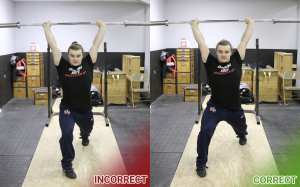
Don’t tightrope in the split.
2. Recovering to the Rear
Nathan had a habit of recovering the back leg first or recovering forwards. This causes most lifters to get unstable and kick the barbell forwards. This can ruin a perfectly good jerk with one simple mistake of a step. The first step should always be with the front leg – just a short step backward. That will keep the barbell in the right place over the traps and back. Once you’ve taken that rear recovery step, you will be in a better position to recover the back leg. This is advice I received from my original coach, Wes Barnett. By the way, he never missed a jerk in competition, so he’s a good one to listen to.
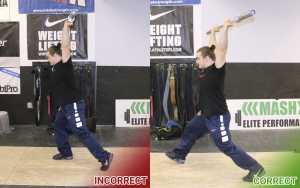
Recover with the front foot stepping back first!
3. Relaxed arms
Now when Nathan recovers from the bottom of a clean, you will see him literally open his hands before beginning the dip and drive. Relaxing his hands helped him relax his arms. Before this, Coach McCauley noticed him punching with his arms too soon. The power of the vertical drive that occurs during the jerk comes from the hips and legs just like anything else powerful. Guys like Mike Tyson knock people out because they have amazing hips. Arms are really just an extension of the hips. If you tense the arms too soon, you run the risk of killing the power generated from the hips. Loose arms are powerful arms, and that is pretty much universal for any sport requiring massive amounts of power. Remember this: hips drive the bar upwards, and the arms drive you under the bar once the vertical drive is complete.
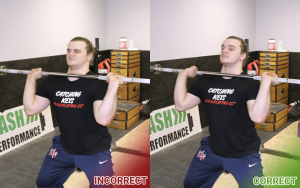
Open up your hands before you dip and drive.
4. Punching up with the Shoulders to Finish
Nathan has always had an explosive vertical drive. However, something would sometimes go wrong with the receiving portion of the jerk. He wasn’t staying ahead of the bar. He would drive it upwards and wait for it to come crashing downwards. Coach McCauley taught him to anticipate the catch of the jerk by reaching upwards through the shoulders. This allowed for a much more stable catch and recovery.
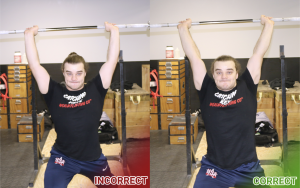
Anticipate the weight overhead and REACH!
5. Driving the Back Leg Down
This is a cue that I learned from Coach McCauley during our time at Team MDUSA. I am not sure who started this cue, but Coach McCauley is the first one to tell me about it. Driving the back leg down aggressively does two important things for making more jerks. First, driving the back leg down will drive your torso through the bar allowing the lifter to catch the bar back behind the ears with the bigger muscles of the traps and back. Driving the back leg down will also cause the back leg to be more stable, which acts more as an anchor for a stable overhead position.
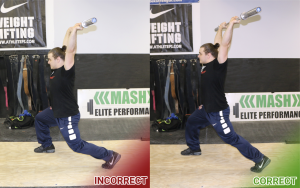
Drive the back leg down for better stability.
6. Getting Tall
This is one of my favorite cues from Coach McCauley. Too many athletes want to think about the split under, but a proper dip followed by a powerful vertical drive will set the athlete up for a perfect split. If you get in a good position before attempting the dip and drive and then drive vertical completely and powerfully, the split is something that occurs naturally. If you do the vertical drive correctly, the split will follow.
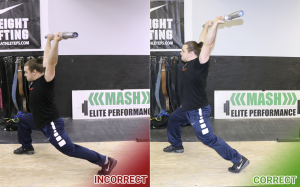
A good dip and tall finish will result in a solid split.
Additional Cues
I also talked to Nathan, and he gave me some more insight. One verbal cue that Coach McCauley didn’t tell me about was: “During the Dip and Drive, sit through the hips and not the quads.”
Nathan said it started feeling like catching a bounce out of the dip and drive and saving the quads for the final extension. He was using too much quads, causing his dip and drive to lose power. When Nathan started getting back towards his heels and sitting through his hips, the dip and drive became much more explosive.
Adding In Jerk Recoveries
Nathan also mentioned the addition of jerk recoveries and jerks from blocks into his program. He had dabbled in both, but Coach McCauley made them a mainstay. It only makes sense. Before Coach McCauley started programming jerk recoveries on a regular basis, Nathan wasn’t able to perform jerk recoveries with the weight that he could actually jerk. Most people can perform jerk recoveries with a lot more than they can jerk. He simply lacked that stability.
The Jerk Recovery Setup:
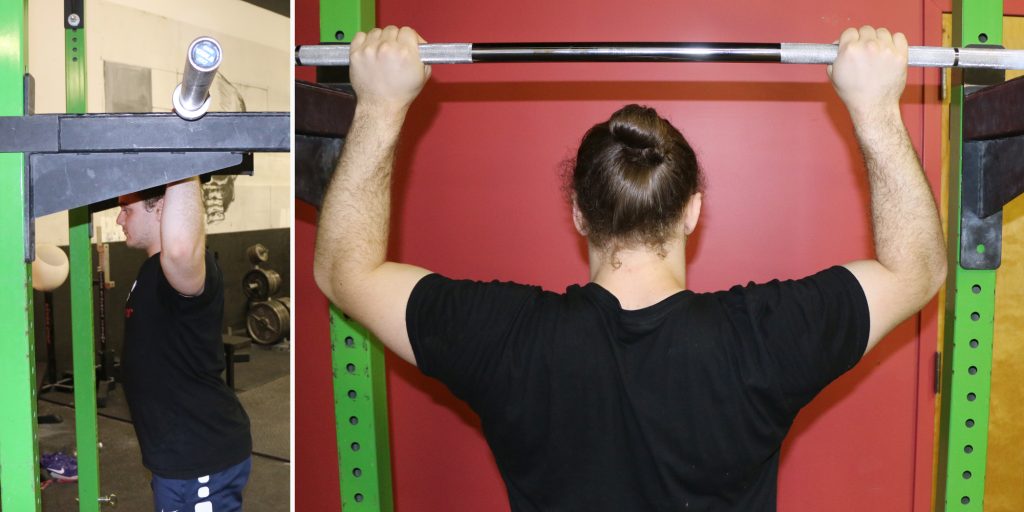
“Receiving” the Bar Overhead:
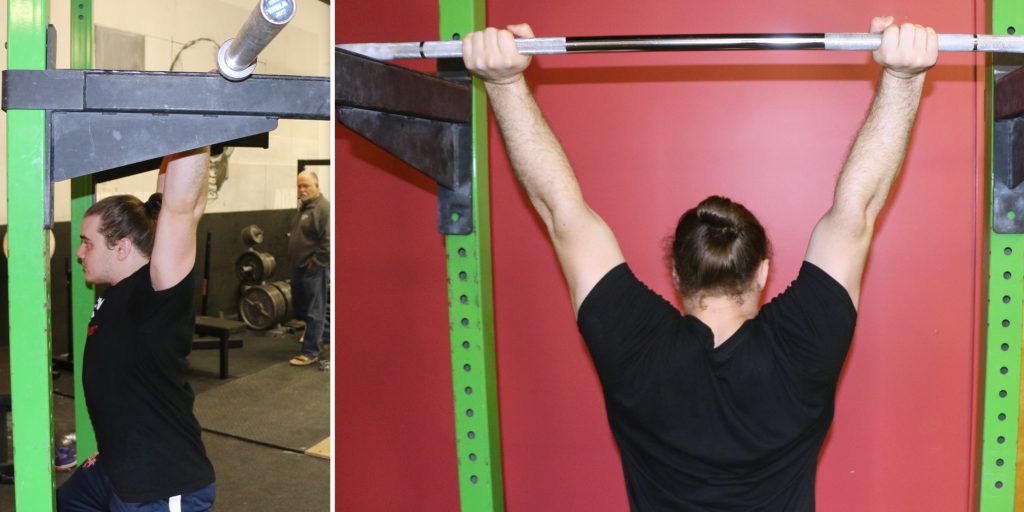
The Recovery:
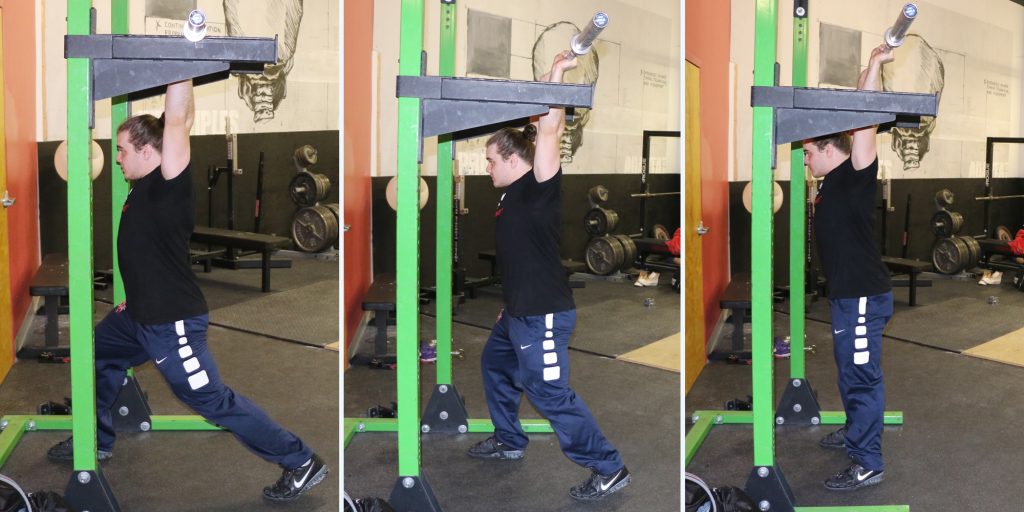
The thing is no one really wants to perform the exercises they aren’t good at. Nathan definitely doesn’t. However, when he started trusting Coach McCauley with his program, he bought totally in and the results showed. The same is true for programming the jerk from racks.
Nathan is amazing at cleans. He’s cleaned 215 kg from blocks, so cleans aren’t a real issue. Jerking from racks/blocks allowed Nathan to focus on his weakness. He performed them every single week under the watchful eye of Coach McCauley, and this allowed Nathan to perfect the technique and build confidence.
Here’s a sample 4-week template for Jerk Recoveries and Jerks from Blocks just to give you an idea of what a program could look like:
Week 1
Day 1
Snatch, Clean and Jerks, Front Squat, Clean Pulls
Day 2
Snatch Variations, Upper Body Accessory work
Day 3
Jerk from Rack – 70% x 2, 75% x 2, 80% x 1, 75% x 2, 80% x 1, 85% x 1, 88% x 1, work up
Clean Variations, Back Squat, Clean Grip Deadlift
Day 4
Snatch Variations
Core Work
Day 5
Snatch Max Effort
Clean and Jerk Max Effort
Muscle Snatches
Day 6
Back Squat
Jerk Recoveries – 5RM, then -10% for 2 x 5
Week 2
Day 1
Snatch, Clean and Jerks, Front Squat, Clean Pulls
Day 2
Snatch Variations, Upper Body Accessory work
Day 3
Jerk from Rack – 75% x 3, 80% x 2, 75% x 2, 80% x 1, 85% x 1, 88% x 1, work up
Clean Variations, Back Squat, Clean Grip Deadlift
Day 4
Snatch Variations
Core Work
Day 5
Snatch Max Effort
Clean and Jerk Max Effort
Muscle Snatches
Day 6
Back Squat
Jerk Recoveries – 5RM, then -10% for 2 x 5
Week 3
Day 1
Snatch, Clean and Jerks, Front Squat, Clean Pulls
Day 2
Snatch Variations, Upper Body Accessory work
Day 3
Jerk from Rack – 70% for 2 x 2, 75% for 2 x 2, 80% for 2 x 1, 85% x 1
Clean Variations, Back Squat, Clean Grip Deadlift
Day 4
Snatch Variations
Core Work
Day 5
Snatch Max Effort
Clean and Jerk Max Effort
Muscle Snatches
Day 6
Back Squat
Jerk Recoveries – 90% of 5RM for 3 x 5
Week 4
Day 1
Snatch, Clean and Jerks, Front Squat, Clean Pulls
Day 2
Snatch Variations, Upper Body Accessory work
Day 3
Jerk from Rack – 78% x 2, 83% x 2, 88% x 1, 90% for 2 x 1, work up
Clean Variations, Back Squat, Clean Grip Deadlift
Day 4
Snatch Variations
Core Work
Day 5
Snatch Max Effort
Clean and Jerk Max Effort
Muscle Snatches
Day 6
Back Squat
Jerk Recoveries – 3RM
[thrive_leads id=’8207′]
Implementing Jerk Recoveries and Jerks From Blocks/Racks into your current program:
For the Jerks, we like to program on a day where we are performing a version of the clean. It just works so much better splitting them up, especially if the jerk is your main focus. Don will sometimes clean one day and jerk the next, putting full focus on the jerks – especially if someone is really struggling. You will notice that the total volume isn’t really that high. I want it high enough to improve neuromuscular coordination, which is a fancy way of saying practice makes perfect. However, I don’t want it so high that form might break down. The whole point is perfecting technique. Both Don and I allow for a slightly higher intensity because jerks from blocks can build some serious confidence in athletes who might otherwise be struggling in the movement.
Jerk recoveries require way less technique, so the main objective of this exercise is strengthening the overhead position of the jerk. You can afford to program a little more volume in this movement due to the low technical rating. I normally program this movement on Saturdays where we put a huge focus on strength in general. This movement will give the athletes a real sense of the importance of position. If they are off at all, the weight won’t budge. For many athletes, jerk recoveries have turned the jerk from their worst movement to their best.
I hope that this article gives you some insight that might help you or one of your athletes. I am not saying that these cues are absolutes. I have seen people create solid jerks with different cues and philosophies. I am just saying what tends to work for us. A lot of coaches can recognize a problem like overhead stability and getting through the bar on the catch. The best coaches actually know how to teach their athletes how to overcome those problems. Maybe this article can help you guys and gals do just that.
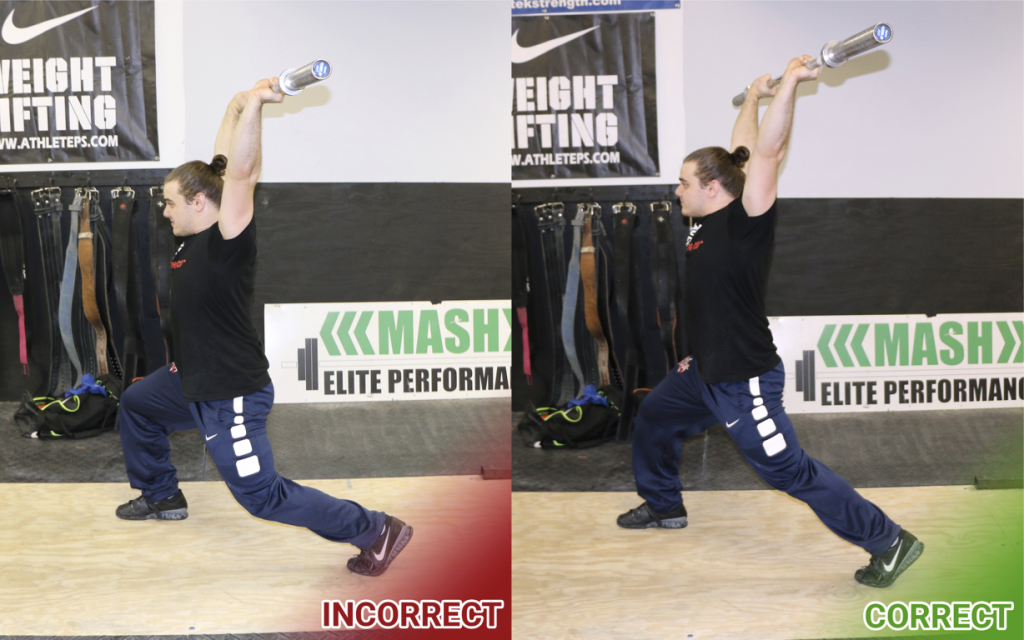
Comments are closed.